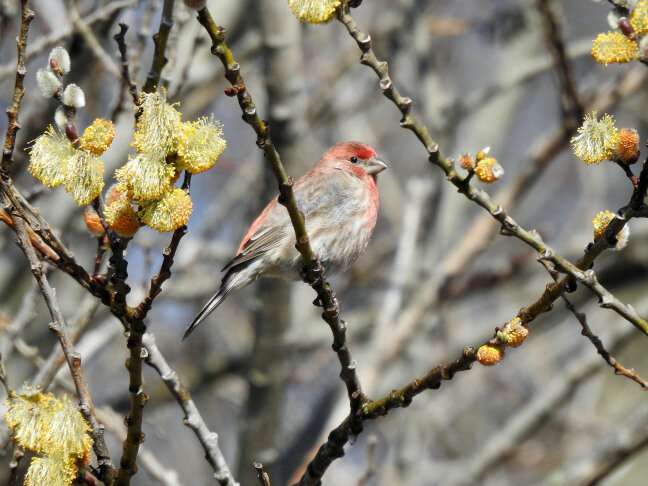
A study examining eye disease in a common bird species shows how pathology and behavior interact in complex ways that determine how widely a pathogen can spread.
The study, published recently in the academic journal Biology Letters, examined pairs of house finches to see how readily mycoplasmal conjunctivitis passes from one bird to another based on lesion severity and feeding behavior. By tracking the severity of disease in infected birds, the researchers noted trends that made transmission more or less likely, said Rachel Ruden, an affiliate assistant professor of veterinary diagnostic and production animal medicine at Iowa State University and a co-author of the study.
Ruden is also the state wildlife veterinarian for the Iowa Department of Natural Resources who has a dual appointment with Iowa State.
"This study is broadly about disease transmission, and how behavior can offset clinical signs when posing a risk of exposing others," Ruden said. "We found that the best conditions for infecting others is when you have severe clinical signs, in our case conjunctivitis, but still maintain a high index of activity, in our case feeding."
Mycoplasmal conjunctivitis commonly infects house finches. The disease tends to break out in waves whenever young birds hit the landscape and are exposed for the first time, Ruden said. Severe cases can lead to noticeable lesions around a bird's eyes. For the study, the researchers looked at 24 house finches in a laboratory setting. The birds were divided into pairs that shared food and water resources. The researchers recorded conjunctivitis symptoms in the birds, feeding behavior of infected individuals, and how long it took to transmit the disease from one bird to the other across pairs.
The experiment showed house finches with severe disease transmitted the pathogen faster than those with less severe disease. The experiment also found maintaining normal feeding behavior led to faster transmission, while birds that cut back on feeding while they were sick took longer to transmit the disease.
The study authors compared conjunctivitis in birds to the spread of seasonal flu among humans.
"If you feel really sick because you have the flu and you're bedridden, you self-isolate and make contact with fewer susceptible hosts versus if you go about your normal day," Ruden said.
It may sound self-evident that more severe disease and higher levels of normal activity make disease transmission more likely. But the study looked at disease severity and behavior as separate variables to analyze competence, or the ability of an individual to infect others.
The study of house finches underscored the importance of disease tolerance by noting that birds with less severe disease that maintained normal feeding behaviors transmitted conjunctivitis just as readily as those with severe disease. The researchers concluded that behavior has just as much effect on transmission as pathology.
That's a situation similar to asymptomatic carriers of COVID-19, she said. Individuals with high disease tolerance might not know they're sick and unintentionally expose others to the pathogen by continuing with their normal activities.
"A lot of times, we just use the pathology piece, the clinical signs, to draw conclusions on transmission," Ruden said. "It turns out there might be other things at play that complicate the picture. If we really want to tease out the transmission dynamics, it's best to take this comprehensive approach where we consider both pathology and behavior. You don't need severe clinical signs to be an effective vector of infection."
Citation: Bird study illustrates the interplay between disease transmission and behavior (2021, November 22) retrieved 22 November 2021 from https://ift.tt/2ZfAsaW
This document is subject to copyright. Apart from any fair dealing for the purpose of private study or research, no part may be reproduced without the written permission. The content is provided for information purposes only.
"behavior" - Google News
November 22, 2021 at 11:21PM
https://ift.tt/2ZfAsaW
Bird study illustrates the interplay between disease transmission and behavior - Phys.Org
"behavior" - Google News
https://ift.tt/2We9Kdi
Bagikan Berita Ini














0 Response to "Bird study illustrates the interplay between disease transmission and behavior - Phys.Org"
Post a Comment